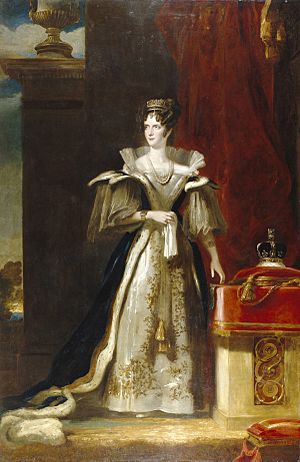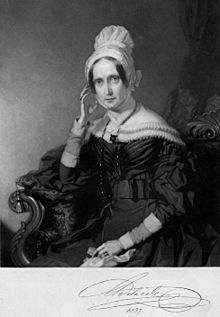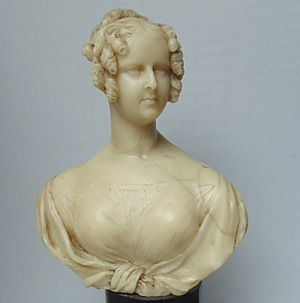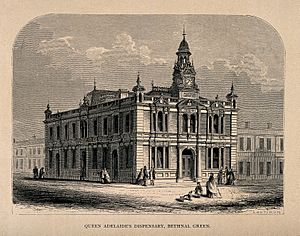Adelaide of Saxe-Meiningen facts for kids
Quick facts for kids Adelaide of Saxe-Meiningen |
|||||
|---|---|---|---|---|---|
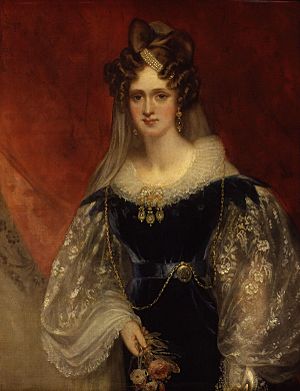
Portrait by Sir William Beechey, c. 1831
|
|||||
| Queen consort of the United Kingdom and Hanover | |||||
| Tenure | 26 June 1830 – 20 June 1837 | ||||
| Coronation | 8 September 1831 | ||||
| Born | 13 August 1792 Meiningen, Saxe-Meiningen, Holy Roman Empire |
||||
| Died | 2 December 1849 (aged 57) Bentley Priory, Middlesex, England |
||||
| Burial | 13 December 1849 Royal Vault, St George's Chapel, Windsor Castle |
||||
| Spouse | |||||
| Issue |
|
||||
|
|||||
| House | Saxe-Meiningen | ||||
| Father | Georg I, Duke of Saxe-Meiningen | ||||
| Mother | Princess Louise Eleonore of Hohenlohe-Langenburg | ||||
| Signature |  |
||||
Adelaide of Saxe-Meiningen (born Adelaide Amelia Louise Theresa Caroline; 13 August 1792 – 2 December 1849) was the Queen of the United Kingdom and Hanover. She was queen from 1830 to 1837 as the wife of King William IV.
Adelaide was born a princess in a small German state. She was known for her kindness and charity. The city of Adelaide, the capital of South Australia, is named after her.
Contents
Early Life of Queen Adelaide
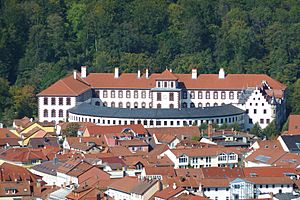
Adelaide was born on 13 August 1792 in Meiningen, Germany. She was the oldest child of Georg I, Duke of Saxe-Meiningen and Luise Eleonore of Hohenlohe-Langenburg. She was given the title Princess Adelaide of Saxe-Meiningen.
Her home state, Saxe-Meiningen, was quite small. It was known for being more open and allowing a free press. This was unusual for German states at that time.
Marriage to William IV
By 1817, the British royal family faced a problem. The King's only grandchild, Princess Charlotte, died during childbirth. This meant there was no clear heir to the throne.
To secure the future of the royal family, the King's sons needed to marry and have children. One of them was Prince William, Duke of Clarence. He had ten children already, but they could not inherit the throne because they were not born within marriage.
William needed to find a wife quickly. Adelaide, though from a small state, was seen as a good choice. She was kind, loved her home, and was willing to accept William's children.
Adelaide and William married on 11 July 1818, at Kew Palace in Surrey, England. They had only met a week before. William was 27 years older than Adelaide. Despite this, they became a devoted couple. Adelaide helped William become more polite and less rough.
The couple wanted to have children who could inherit the throne. Adelaide became pregnant several times, but sadly, none of her children survived.
- Their first daughter, Charlotte, lived only a few hours in 1819.
- Another pregnancy ended in a miscarriage later that year.
- A second daughter, Elizabeth, was born in 1820 but died when she was three months old.
- Twin boys were stillborn in 1822.
Because of these tragedies, William and Adelaide had no surviving children.
Becoming Queen Consort
In 1827, William became the next in line to the throne. This happened when his older brother, Frederick, died without children. Everyone expected William to become king.
In 1830, William's oldest brother, King George IV, died. William then became King. He and Adelaide were crowned on 8 September 1831 at Westminster Abbey.
William was not very fond of the coronation ceremony. But Adelaide took it very seriously. People praised her for her "dignity" and grace during the event.
As Queen, Adelaide was very popular with the British people. She was known for being religious, modest, and very charitable. She gave a lot of her income to help others.

Since Adelaide had no surviving children, Princess Alexandrina Victoria of Kent (who later became Queen Victoria) was the next in line to the throne. Adelaide was kind to young Princess Victoria. She and William wanted Victoria to spend more time with them. However, Victoria's mother, the Duchess of Kent, often made this difficult.
There was some tension between the King and Queen and the Duchess of Kent. King William once spoke strongly about his unhappiness with the Duchess. Despite this, Victoria always remembered Adelaide and William with kindness.
Adelaide was interested in politics, but she never spoke about it in public. She was thought to be against some major changes happening in the country at the time. However, she was careful not to show her political views openly.
Life as Queen Dowager
In 1837, King William IV became very ill. Adelaide stayed by his side for over ten days without much rest. William IV died on 20 June 1837.
After William's death, Adelaide became the "Queen Dowager." This means she was the widow of a king. She was the first Queen Dowager in Britain in over a century. Adelaide lived for twelve more years after her husband.
For her health, Adelaide traveled to warmer places. In 1838, she visited Malta. She paid for the building of St Paul's Pro-Cathedral there, as there was no Protestant church. In 1844, she made her last visit to her home country, Germany.
Adelaide lived in several country houses across England. She was often ill and moved around hoping to find a climate that would help her health. She was known for her generosity and continued to support many charities. For example, she helped fund the first village school in Great Witley.
Her last public appearance was to lay the foundation stone for a church in Great Stanmore. She gave the church its baptismal font.
Queen Adelaide died on 2 December 1849 at Bentley Priory in Middlesex. She was buried in the Royal Vault at St. George's Chapel, Windsor.
Legacy
Queen Adelaide's name is still remembered in many places. The most famous is Adelaide, the capital city of South Australia. It was named after her in 1836. There is a statue of her in the city's Town Hall.
Many other places around the world are named after her, including:
- A village called Queen Adelaide in England.
- Adelaide Streets, Avenues, and Roads in various cities.
- Adelaide Hospital in Dublin, Ireland.
- Two Adelaide Rivers in Australia.
- The town of Adelaide in South Africa.
- Queen's Park, Brighton in England.
- Adelheidsdorf in Germany.
- Fort Adelaide in Port Louis, Mauritius.
- Queen Adelaide Archipelago and Adelaide Island in Chile and Antarctica.
In London, after a serious illness outbreak in 1849, the Queen Adelaide's Dispensary opened. This was a place where people could get medical and dental care. Today, it still operates as Queen Adelaide's charity.
Queen Victoria's first child, Victoria Adelaide Mary Louise, was named partly after Queen Adelaide. Adelaide was also her godmother.
Cultural Depictions
Queen Adelaide has been shown in films and TV shows.
- In the 2009 film The Young Victoria, she was played by Harriet Walter.
- Delena Kidd played her in the 2001 TV series Victoria & Albert.
Honours
 Kingdom of Portugal: Dame of the Order of Queen Saint Isabel, 1836
Kingdom of Portugal: Dame of the Order of Queen Saint Isabel, 1836 Russian Empire: Dame Grand Cross of the Order of Saint Catherine, 1830
Russian Empire: Dame Grand Cross of the Order of Saint Catherine, 1830
See also
 In Spanish: Adelaida de Sajonia-Meiningen para niños
In Spanish: Adelaida de Sajonia-Meiningen para niños
Images for kids



